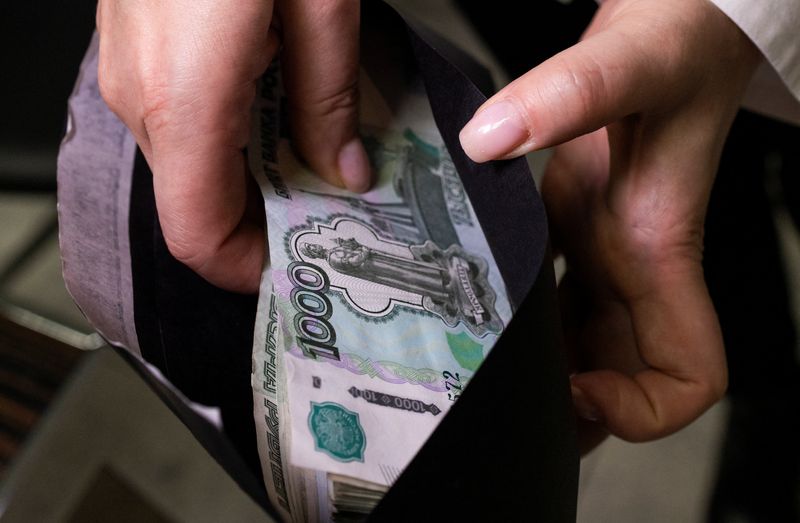
By Gleb Bryanski
MOSCOW (Reuters) -The Russian rouble weakened beyond the 110 mark to the U.S. dollar on Wednesday, a threshold that some analysts believe could prompt authorities to take action to support the currency, which has fallen by more than 24% since early August.
The rouble’s fall caught off guard economists who had expected the Russian currency to hit the 100 mark against the dollar in one year, according to the Reuters poll in early November. It hit a 32-month low last week.
By 1300 GMT the rouble was down 3.42% at 109.10 against the dollar, after touching 111.20, according to LSEG data. It was down by almost 2% at 14.97 against the yuan, also the lowest level since March 2022, the first month of Russia’s invasion of Ukraine.
The rouble’s fall has been compounded by a fall of more than 20% in the stock market so far this year as investors shift their savings from stocks to deposits, which offer interest above the central bank’s benchmark rate of 21%.
“The market is awaiting the financial authorities’ reaction for the rouble’s devaluation,” BCS brokerage analysts said, stressing that forex purchases “resembled panic in an environment of uncertainty”.
Analysts are now predicting that the rouble may hit 115-120 before the end of the year, with some calling on the government and the central bank to take action such as forcing exporters to sell more forex and increasing forex sales by the state.
“Possible measures may include increasing foreign currency sales by the central bank through adjustments to the parameters of operations under the budget rule and additional capital controls,” said analyst Sofya Donets from T-Bank.
INFLATION CONCERNS
The rouble’s fall is fuelling inflation, which is set to exceed the central bank’s estimate for this year, working counter to the regulator’s painful monetary tightening with the benchmark interest rate at the highest level since 2003.
The central bank estimates that the rouble’s weakening by 10% adds 0.5 percentage points to inflation, implying that the rouble’s four-month fall could add 1.5 percentage points to the current inflation rate.
“For the central bank, it represents a challenge in combating rising prices,” economist Evgeny Kogan said.
The central bank and the finance ministry did not respond to a Reuters request for comment on the exchange rate.
The rouble’s slide was exacerbated by the new sanctions on Russia’s financial sector, which disrupted foreign trade payments, especially for oil and gas, creating a physical shortage of currency in the Russian market, analysts said.
Most Russian major banks are now under the U.S. sanctions and are therefore unable to carry out bank transactions in dollars and the only remaining option to trade foreign currency for them is to import large quantities of dollar cash.
All trade in dollars and euros moved to the over-the-counter market after Western sanctions were imposed on the Moscow Exchange (MOEX). As a result, the trade has become volatile and opaque, with most banks disclosing data only to the regulators.
Many analysts stressed that apart from a new round of tensions with the West over Russia’s military action in Ukraine and new financial sanctions, there were no fundamental reasons for the fall, with prices for oil, Russia’s main export, broadly stable.
The weak rouble is beneficial for exporting companies, according to Finance Minister Anton Siluanov, with prices for Russia’s energy exports mostly set in dollars.

It is also helping the Russian government to increase the state budget revenues from energy taxes and export duties.
“The main reason for such a significant weakening is that, in our opinion, this weakening is desirable, said Finam brokerage analyst Nikolai Dudchenko. “Today, the exchange rate is very much conducive to balancing the budget,” he added.
This post is originally published on INVESTING.




